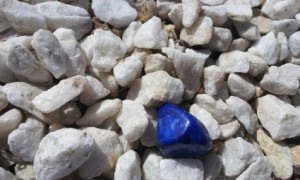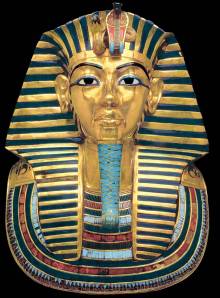 I don’t know much about purple, but I did come across some interesting facts about the color blue this past week. I’m taking an art history course at the University of New Hampshire, and have been bombarded with a plethora of awesome images of art over the past 40,000 years or so, from cave drawings to abstract expressionism. It amazes me to see some of the exquisite detail put into drawings and sculptures back when people used their hands to paint and carving tools consisted of sharpened rocks or bones. Not only that, but the amount of effort put into buildings is mind-blowing (think the Parthenon or the Pyramids of Giza). Sometimes it seems they were better off before modern engineering and technology…
I don’t know much about purple, but I did come across some interesting facts about the color blue this past week. I’m taking an art history course at the University of New Hampshire, and have been bombarded with a plethora of awesome images of art over the past 40,000 years or so, from cave drawings to abstract expressionism. It amazes me to see some of the exquisite detail put into drawings and sculptures back when people used their hands to paint and carving tools consisted of sharpened rocks or bones. Not only that, but the amount of effort put into buildings is mind-blowing (think the Parthenon or the Pyramids of Giza). Sometimes it seems they were better off before modern engineering and technology…
In order to learn about the history of art, we had to delve into the history of colors. Some colors were easy to come across throughout the early years, as their pigments were found abundantly in plants or stones, but some colors were not. Blue was one of those colors. In fact, blue was not able to be used as a color until about 6,000 years ago. Until then, everyone had to imagine the azure sky or a cobalt sea on the paintings they saw. So what happened to make the change? Two words: Lapis Lazuli.
If you’ve ever read George R. R. Martin’s series The Song of Ice and Fire (some of my favorite books, by the way), then you’ve probably heard of lapis. I’m sure many other authors have used it in their stories, as well, but his are most notable to me, and he uses the semi-precious stone quite a bit. I had never heard of it before reading his books, though. And to be honest, I thought it was made up at first. But after searching the dictionary, I found it to be a deep blue stone, and looked no further. What I didn’t realize, and what I have since learned, is that the stone (pictured above) can mostly only be found in Afghanistan. It’s been found elsewhere, as well, but it is most abundant in Afghanistan.
 Now, 6,000 years ago, Afghanistan was right in the middle of the trade route between Egypt and China. So those two cultures, and everywhere in between, were the biggest users of lapis lazuli. The Egyptians loved it. They put it and gold on everything important, especially Pharoah masks and tombs. It’s all over King Tutankhamen’s burial mask, as you can see. Cleopatra used it in her eye shadow. They loved the scarce stone so much that they tried to recreate it using chemistry. They weren’t able to, but they did create Egyptian Blue by combining copper, sand, and limestone. Obviously, they didn’t call it that, but they did use it quite a bit, until they were conquered by the Romans anyway, and the process was forgotten.
Now, 6,000 years ago, Afghanistan was right in the middle of the trade route between Egypt and China. So those two cultures, and everywhere in between, were the biggest users of lapis lazuli. The Egyptians loved it. They put it and gold on everything important, especially Pharoah masks and tombs. It’s all over King Tutankhamen’s burial mask, as you can see. Cleopatra used it in her eye shadow. They loved the scarce stone so much that they tried to recreate it using chemistry. They weren’t able to, but they did create Egyptian Blue by combining copper, sand, and limestone. Obviously, they didn’t call it that, but they did use it quite a bit, until they were conquered by the Romans anyway, and the process was forgotten.
Their discovery spread, though, and soon other nations began to develop their own blue pigments through chemistry. The Greeks and the Roman built factories just to produce blue pigments. The Chinese took it a step further. They used elements like barium and mercury in their blues, and, well, I’m sure you know what happened to them. Like the Daguerreoptypists in a previous post I wrote, who used mercury vapors to develop pictures, the Chinese emperors who surrounded themselves by these new blues suffered poisonous deaths.
 The Mayans were also successful in creating a blue pigment, but they did so with a more natural ingredient. They used an extract from the indigo plant to create a color known as Mayan Blue (again, I could be wrong, but that’s probably not what they called it). Or at least it’s believed that’s where the pigment came from. We can’t exactly ask them how they did it any more. Whatever the case may be, blue was still a very rare color to come across, and was pretty much used for royalty.
The Mayans were also successful in creating a blue pigment, but they did so with a more natural ingredient. They used an extract from the indigo plant to create a color known as Mayan Blue (again, I could be wrong, but that’s probably not what they called it). Or at least it’s believed that’s where the pigment came from. We can’t exactly ask them how they did it any more. Whatever the case may be, blue was still a very rare color to come across, and was pretty much used for royalty.
I love using blue in my writing. Especially blue eyes. Blue eyes seem to be the most piercing, striking, and serious, but they also seem to be mysterious. I wrote an entire story (“The Masquerade”) around a mysterious and deadly woman, whose only feature that could be seen, besides her hair, was her bright and melancholic blue eyes. I love focusing on a beautiful blue sky just before revealing something dark and ghastly on ground level. One thing I have learned is that you don’t need a dark and ominous setting to reveal something equally dark and ominous. It’s too cliche now. It’s been overdone. Sometimes using stark contrast has a better effect. But don’t take my word for it, try it yourself.
I’m really happy I decided to take the art history course. Not just because I learned about blue, but because looking at other people’s stories, or their adaptations of the surrounding environment, helps to open my mind and be more perceptive to my own surroundings, which in turn improves my writing. I had a fiction teacher last year who brought us to an art gallery and asked us to write a story about something in the gallery. It was an incredible experience, and one I plan to do again on my own. In fact, I am already being inspired just by seeing pictures of the sculptures, drawings, and buildings that have been created in the past. It’s amazing how our creativity can be stimulated by somebody else’s creativity.
Something else I learned through blue is that the Catholic church once color-coded the saints (or maybe still do, who knows). Blue was chosen for Mary, and from then on her robes were always blue. That was 1500 years ago, though, so who knows if they still practice that strange custom. And the reason people of authority always seem to be dressed in blue? It’s the color of trustworthiness, harmony, faithfulness, and confidence (and sometimes sadness, but let’s not be blue about it).
